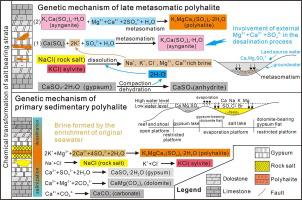Ore Geology Reviews ( IF 3.2 ) Pub Date : 2021-09-02 , DOI: 10.1016/j.oregeorev.2021.104439 Da-Xing Gong 1 , Bin Xiao 2 , Leon Bagas 3, 4 , Die Li 2 , Jia-Yun Zhou 1 , Hao Zou 2, 3

|
Polyhalite is a special potash fertilizer resource, which is widely distributed in the Triassic evaporite strata in the Sichuan Basin, but its genetic mechanism has always been controversial. This contribution presents new petrological, geochemistry, electron probe analyses, and Ca-S isotope systematics on Triassic polyhalite minerals for the first time from the Sichuan Basin aiming to better understand their origin. We present petrological observations of long columnar and granular polyhalites co-existing with halites (rock salt) and anhydrites that are not metasomatic in origin. Metasomatic polyhalites have also been studied, which have a fibrous and radial habit interwoven with anhydrite. The primary (sedimentary) polyhalite is solely formed from the evaporation of seawater, and the formation of metasomatic polyhalite involved impure meteoric water. The Ca and S isotopic values show that the sulphur and calcium in diamond-drillholes ZK001 and ZK601 are derived from seawater, whereas the sulphur and calcium in Well YS01 are derived from meteoric water. The sulphur and calcium in Well ZK02 are derived weathered terrigenous gypsum. This study demonstrates that the combined sulphur (δ34S) and calcium (δ44/40Ca) isotopes can be used to reveal the genesis of polyhalite.











































 京公网安备 11010802027423号
京公网安备 11010802027423号